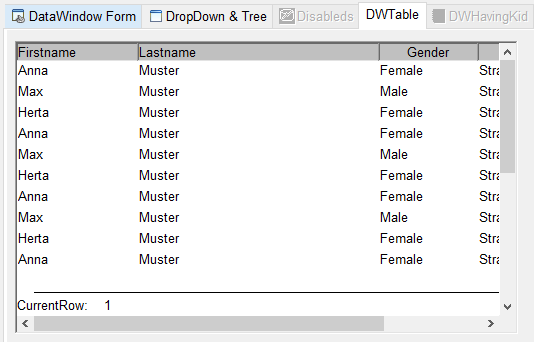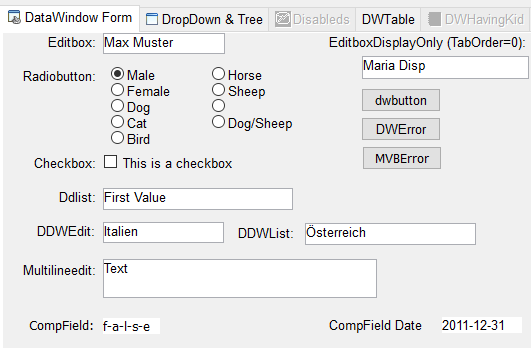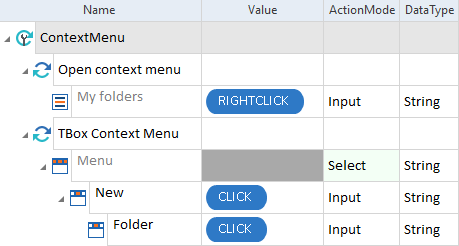Steer WinX Engine 3.0 controls
With the WinX Engine 3.0, you can steer controls in Powerbuilder applications or applications that utilize the Windows UI API.
You can steer the following controls with the WinX Engine 3.0:
Context menu
Context menus can disappear when the application focus changes. When this happens, Tosca XScan can't detect the control when you scan the application. In this case, use the Module TBox Context Menu to steer context menus. This Module is part of the Standard subset and you can find it under TBox Automation Tools->Basic Windows Operations.
If your application contains a custom context menu which doesn't disappear when the focus changes, use Tosca XScan to scan it and the respective Module to steer it.

|
In the example below, you perform the following actions:
Steer a context menu example |
DataWindow
DataWindow is a complex but versatile control in PowerBuilder applications. Typically, it's used to display and/or manipulate data within a contained space.
Enable DataWindow control recognition in Tosca XScan
To work with DataWindow controls in Tosca, you need to manually enable each application before the actual scan with Tosca XScan. This certifies that Tricentis Tosca can correctly identify and steer this type of control in your applications.
To do so, follow these steps:
-
Go to C:\Program Files (x86)\TRICENTIS\Tosca Testsuite\TBox\Powerbuilder and launch the Windows Command Prompt. We recommend you do so with administrator rights, as some actions may require additional permissions.
-
For each Powerbuilder application you want to steer with Tosca, run this command:
Tricentis.Automation.PowerbuilderEnabler.exe <pathToRuntimeDlls>
Replace <pathToRuntimeDlls> with the path to the folder which contains the Powerbuilder runtime DLLs, such as pbvm.dll. Example: C:\Program Files\MyPBApp.
Understand how to steer a DataWindow control
Generally, DataWindow controls tend to look like one of the following:
-
A table. In this case, you have to steer this control the same way you steer a
 Table. There may be controls embedded within the table cells, and not all of them are visible. If you have visible or invisible embedded controls in the table, you have to define these controls in their respective cells to steer them.
Table. There may be controls embedded within the table cells, and not all of them are visible. If you have visible or invisible embedded controls in the table, you have to define these controls in their respective cells to steer them.

Example of a DataWindow control in a Powerbuilder application that you steer as a Table.
-
A container for other controls. In this case, you may see controls such as
 Buttons,
Buttons,  Labels, or
Labels, or  Checkboxes in a contained space of your application. These embedded controls appear under a Container in Tosca XScan. Here, you can simply select which of these controls you want to add to your Module.
Checkboxes in a contained space of your application. These embedded controls appear under a Container in Tosca XScan. Here, you can simply select which of these controls you want to add to your Module.

Example of a DataWindow control in a Powerbuilder application that you steer as a Container of other controls.
ListView
Tosca XScan identifies ListView types such as Icon, SmallIcon, or List as a ListBox. You can steer them as described in chapter "Listbox", except for the Text property, which you can't verify.
ListViews of the type Details are identified as a Table. You can steer them as described in chapter "Table".
Additionally, you can verify the following properties:
|
Property |
Description |
|---|---|
|
Selected |
Verifies if the entry is selected. |
|
Focused |
Verifies if the entry is focused. You can't verify this property if the control is identified as a table. |

|
In the example below, you verify if Item B is selected.
ListView verification example |
TreeNode
TreeNodes are part of the control type TreeView. You can steer them as described in chapter "TreeView"
Additionally, you can verify the following properties:
|
Property |
Description |
|---|---|
|
Expanded |
Verifies if the entry is expanded. |
|
Selected |
Verifies if the entry is selected. |

|
In the example below, you verify if the TreeNode named Car Listing is expanded.
TreeNode verification example |


